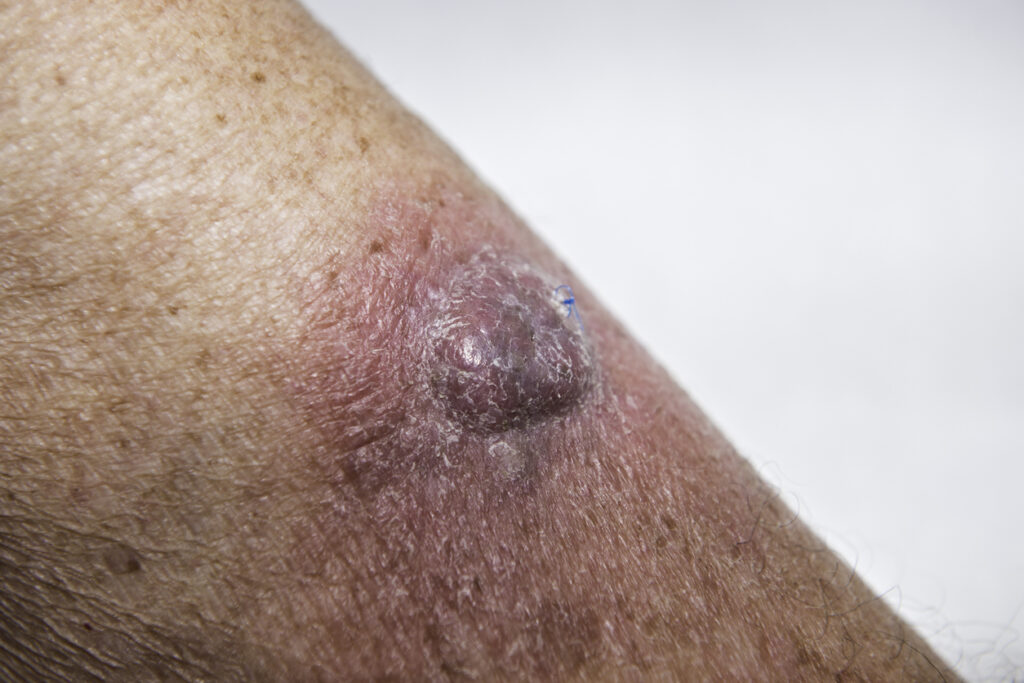New research adds a third validated use to the DecisionDx-SCC for patients with high-risk cutaneous squamous cell carcinoma (SCC): The test can predict local recurrence in patients classified as high-risk by National Comprehensive Cancer Network (NCCN) guidelines who have undergone Mohs resection.
DecisionDx-SCC is a gene expression profile test (40-GEP) designed to use a patient’s tumor biology to predict individual risk of metastasis as well as response to adjuvant radiation therapy (ART). It has now also been shown to predict individual risk of local recurrence.
“These new data indicate that DecisionDx-SCC test results provide individualized risk predictions that doctors can use to guide risk-aligned escalation or de-escalation of care in their NCCN high-risk SCC patients,” says Désirée Ratner, MD, a Mohs Micrographic Surgeon and Clinical Professor of Dermatology at the NYU Grossman School of Medicine in New York, NY, in a news release. “The ability of the test to reliably identify those patients with NCCN high-risk SCC at risk of developing local recurrence or metastasis is not only practice-changing for physicians who treat SCC, but also life-changing for their patients.”
Demonstrates Improvements in Predictions
While most patients with NCCN high-risk SCC can be treated successfully with Mohs surgery, a subset of these patients will experience local recurrence and/or metastasis. Current staging systems, including the American Joint Committee on Cancer (AJCC) version 8 staging and the Brigham and Women’s Hospital (BWH) T-staging, inadequately identify which patients are at the highest risk for poor outcomes. This limitation makes it challenging for clinicians to determine optimal treatment strategies, leading to over-treatment of low-risk patients and under-treatment of high-risk patients who may benefit from escalated approaches such as ART or enhanced post-surgical surveillance.
Among 414 NCCN high-risk SCC patients with negative margins following Mohs surgery, DecisionDx-SCC significantly stratified both local recurrence and metastatic risk. Three-year survival rates decreased progressively across risk classes: local recurrence-free survival (LRFS) was 95.3% (Class 1, low risk) vs. 85.5% (Class 2A, higher risk) vs. 71.4% (Class 2B, highest risk); metastasis-free survival (MFS) was 97.1% vs. 89.3% vs. 57.1%.
By contrast, BWH and AJCC staging systems failed to significantly stratify LRFS and MFS. DecisionDx-SCC test results (Class 2A and 2B), immunosuppression, and perineural invasion were significant predictors of local recurrence.
When combined with these two clinicopathologic factors, which have a well-established association with a high risk of metastasis, DecisionDx-SCC demonstrated significant improvement in predictive accuracy compared to the clinicopathologic factors alone.
Survey: DecisionDx-SCC Impacts Recommendations
A related survey of 244 clinicians revealed that the test influences their recommendations, particularly in the use of ART and surveillance imaging, by providing actionable decision points based on individual patient risk.
The clinicians surveyed in the second study most often recommended ART for patients with ≥20% risk of local recurrence or metastasis, and surveillance imaging for patients with ≥10% risk of metastasis. Accordingly, DecisionDx-SCC Class 2A results accurately predicted risk above the 10% threshold, where most clinicians would recommend surveillance imaging and consider ART. In comparison, Class 2B results predicted risk above the 20% threshold, where most clinicians would recommend proceeding with ART. Clinicians who use DecisionDx-SCC reported a Class 2B test result to be among the most important risk factors they consider when making management decisions for ART.


